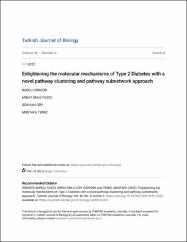| dc.contributor.author | Bakır Güngör, Burcu | |
| dc.contributor.author | Ünlü, Yazıcı, Miray | |
| dc.contributor.author | Göy, Gökhan | |
| dc.contributor.author | Temiz, Mustafa | |
| dc.date.accessioned | 2022-12-16T08:38:29Z | |
| dc.date.available | 2022-12-16T08:38:29Z | |
| dc.date.issued | 2022 | en_US |
| dc.identifier.issn | 1300-0152 | |
| dc.identifier.issn | 1303-6092 | |
| dc.identifier.uri | https://doi.org/10.55730/1300-0152.2620 | |
| dc.identifier.uri | https://hdl.handle.net/20.500.12573/1428 | |
| dc.description.abstract | Type 2 diabetes mellitus (T2D) constitutes 90% of the diabetes cases, and it is a complex multifactorial disease. In the last decade, genome-wide association studies (GWASs) for T2D successfully pinpointed the genetic variants (typically single nucleotide polymorphisms, SNPs) that associate with disease risk. In order to diminish the burden of multiple testing in GWAS, researchers attempted to evaluate the collective effects of interesting variants. In this regard, pathway-based analyses of GWAS became popular to discover novel multigenic functional associations. Still, to reveal the unaccounted 85 to 90% of T2D variation, which lies hidden in GWAS datasets, new post-GWAS strategies need to be developed. In this respect, here we reanalyze three metaanalysis data of GWAS in T2D, using the methodology that we have developed to identify disease-associated pathways by combining nominally significant evidence of genetic association with the known biochemical pathways, protein-protein interaction (PPI) networks, and the functional information of selected SNPs. In this research effort, to enlighten the molecular mechanisms underlying T2D development and progress, we integrated different in silico approaches that proceed in top-down manner and bottom-up manner, and presented a comprehensive analysis at protein subnetwork, pathway, and pathway subnetwork levels. Using the mutual information based on the shared genes, the identified protein subnetworks and the affected pathways of each dataset were compared. While most of the identified pathways recapitulate the pathophysiology of T2D, our results show that incorporating SNP functional properties, PPI networks into GWAS can dissect leading molecular pathways, and it could offer improvement over traditional enrichment strategies. | en_US |
| dc.language.iso | eng | en_US |
| dc.publisher | TUBITAK | en_US |
| dc.relation.isversionof | 10.55730/1300-0152.2620 | en_US |
| dc.rights | info:eu-repo/semantics/openAccess | en_US |
| dc.subject | Genome-wide association study (GWAS) | en_US |
| dc.subject | multiple association studies, single nucleotide polymorphism (SNP) | en_US |
| dc.subject | subnetwork identification | en_US |
| dc.subject | pathway subnetwork | en_US |
| dc.subject | pathway clustering analysis | en_US |
| dc.subject | type 2 diabetes | en_US |
| dc.title | Enlightening the molecular mechanisms of type 2 diabetes with a novel pathway clustering and pathway subnetwork approach | en_US |
| dc.type | article | en_US |
| dc.contributor.department | AGÜ, Mühendislik Fakültesi, Bilgisayar Mühendisliği Bölümü | en_US |
| dc.contributor.authorID | 0000-0002-2272-6270 | en_US |
| dc.contributor.authorID | 0000-0001-8165-6164 | en_US |
| dc.contributor.institutionauthor | Bakır Gungor, Burcu | |
| dc.contributor.institutionauthor | Ünlü Yazıcı, Miray | |
| dc.contributor.institutionauthor | Göy, Gökhan | |
| dc.contributor.institutionauthor | Temiz, Mustafa | |
| dc.identifier.volume | 46 | en_US |
| dc.identifier.issue | 4 | en_US |
| dc.identifier.startpage | 318 | en_US |
| dc.identifier.endpage | 341 | en_US |
| dc.relation.journal | Turkish Journal of Biology | en_US |
| dc.relation.publicationcategory | Makale - Uluslararası Hakemli Dergi - Kurum Öğretim Elemanı | en_US |


















